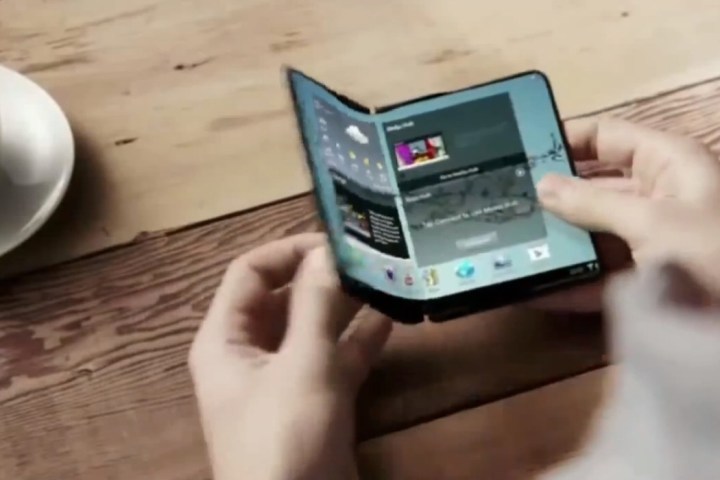
Work has reportedly begun in earnest. The design will feature a pair of flexible 5-inch, nearly bezel-less OLED displays joined by a single hinge that can be folded 180 degrees. And Samsung’s developing software with multitasking features that take advantage of its unfolded, effective 10-inch resolution.
The Investor speculates that it’s a preliminary version of the company’s long-rumored foldable smartphone, the Galaxy X.
The reports follow on the heels of Samsung’s Project Valley, an “early vision” of a foldable smartphone that featured a single flexible panel. It’s not a new idea — as The Verge points out, both NEC’s Medias W N-05E and the Kyocera Echo featured collapsing dual-screen designs. But it’s the first material effort from Samsung, which has long expressed its intention to build a foldable handset small enough to fit in a pocket.
Samsung plans to make between 2,000 and 3,000 units in the first half of 2017. According to The Investor, Samsung and its display-making arm Samsung Display have been accelerating development for a pilot test with “tens of thousands” of prototypes during the second half of this year.
But don’t hold your breath for a mass-market launch anytime soon. In April, Samsung Display’s principal engineer, Kim Tae-woong, said the company is currently focused on bezel-free displays. “Because the bezel-free display current sells well, we still have enough time to develop foldable displays,” Kim told The Verge. Samsung is pegging 2019 as the year it will commercialize foldable phones.
The comments were at odds with a Bloomberg report which claimed that Samsung would release two bendable smartphones: One that folded in half, and another with a 5-inch display that “unfurled” into a tablet-sized 8-inch panel. But one thing’s for certain: Samsung’s chasing rivals.
At an event in June 2016, Lenovo showed off a concept smartphone that uses a flexible screen and segmented body to converted from a watchband to a handset. And at the Consumer Electronics Show in January, LG Display showed off a prototype 18-inch screen that rolls up like a sheet of paper.
“Since foldable products draw the most attention in markets recently, it is important to understand demands and ideas regarding new UX through this prototype,” a source told ET News. “This is part of Samsung Electronics’ effort to introduce foldable Smartphones as ultra-premium products.”
Editors' Recommendations
- Samsung Galaxy Z Flip 6: news, rumored price, release date, and more
- iPhone Flip: what we know about Apple’s first foldable phone
- Samsung’s next folding phone could have a shocking price
- Is the Samsung Galaxy S23 still worth it 10 months later?
- I used Samsung’s next big smartphone update. Here’s why I love it


